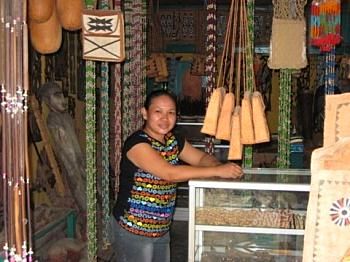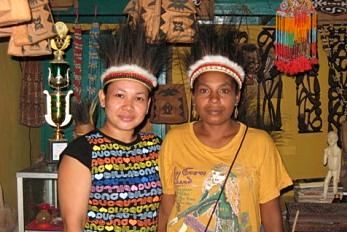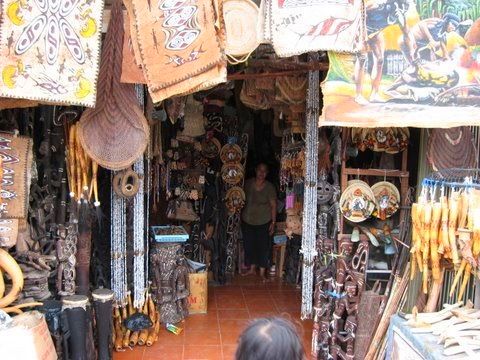Iskandar Nugroho
Papuan culture on sale at the Hamadi art market in JayapuraIskandar Nugroho |
After an absence of nearly six months, Haji Sarip has returned home to his wife and children in the Papuan capital of Jayapura. He’s just completed an arduous journey in search of artefacts in the inland regions of southern Papua. Most of his time was spent in the small village of Marind Papua, watching local people make a series of ‘historical’ artefacts and other objects for him to take back to Jayapura. Along with the Kamoro tribe, the Asmat and Marind people are well-known as producers of the type of artefacts sought out by visitors to the art shops of the provincial capital.
The long days Haji Sarip spent travelling by small plane, in tribal canoes and trekking through the jungle have been well worth the effort. Now piled up in the corner of his simple shop in Pasar Hamadi in Jayapura are statues, Marind drums and shields covered with Asmat engravings. Haji Sarip knows these things will sell quickly, and for a good price – if not here in Jayapura, then in the tourist shops of Bali. Either way, the results of his costly expedition should soon provide him with enough money to meet the needs of his extended family.
Manufacturing tradition
The artefacts displayed in Haji Sarip’s shop are not the only products of his journey into the interior. In return for supplies of instant noodles, cooking oil, salt or MSG, he has procured penis sheaths, dead birds of paradise, cuscus skins, maleo eggs, feathers from protected bird species, wild boar tusks, and the precious stones and dried seeds that are used as jewellery in traditional Papuan costumes. He also has a collection of photos taken with his digital camera of semi-naked indigenous people in various poses.
It is not unusual to see Haji Sarip decorating penis sheaths with ‘primitive’ designs that are difficult to trace to any indigenous Papuan tribe
Once back in Jayapura, these items become the raw material that Haji Sarip and his family turn into souvenirs. Some of their creations are inspired by pictures in books given to him by a foreign anthropologist who visited his shop decades ago. Others are the products of his own imagination. Either way, it is not unusual to see Haji Sarip busy with his coloured marker pens, decorating penis sheaths with ‘primitive’ designs that are difficult to trace to any indigenous Papuan tribe. His wife and children, even his mother-in-law, spend their time carefully sewing together arrangements of feathers, precious stones and photos of indigenous Papuans dressed in warfare costumes before attaching them to cardboard and drying them in the sun beside the open drains that run past the shop.
 |
Carrying on the family business: Ririn is a member of Haji Sarip’s
|
These new creations represent the Sarip family’s interpretation of Papuan exoticism, a view of Papuan people as primitive, warlike and backward. In Haji Sarip’s view, they are ‘richer’ and ‘more beautiful’ than the things they are made from, collected in the interior. Importantly also, they are now saleable items that help boost his shop’s meagre turnover.
From souvenir to symbol
Haji Sarip’s shop is located in Pasar Hamadi, the marketplace said to be named after Achmadi, the first outsider to engage in trade with the local people in Jayapura. The marketplace is now one of the city’s landmarks, a magnet for foreign and domestic tourists in search of mementoes of their stay in Papua. Haji Sarip is one of dozens of traders from South Sulawesi who have set up handicraft shops there.
Apart from sharing a common ethnicity and religion, these Bugis traders from South Sulawesi now form their own business community. They are part of an extensive network that takes in all the major Papuan towns, and extends as far as Bali and Jakarta. Their ethnic and family connections give them a strong sense of belonging, and they work together and support each other in the hunt for cultural artefacts to sell.
With an obvious sense of pride in his achievements, Haji Sarip tells the story of how he was the one who began manufacturing new cultural items as souvenirs for the tourist trade 30 years ago. At first he was annoyed when others in the souvenir industry began copying him to build up their own thriving businesses, but now the competition has begun to slacken off.
 |
Posing with a traditional headdress, as interpreted by the Sarip familyIskandar Nugroho |
Some of Haji Sarip’s creations have now become well-known symbols of Papuan culture. The battle headdress which now appears regularly on the national and international stage as a representation of Papuan culture is, he says, one of his designs. Made from precious stones, coloured seeds and bird of paradise feathers, it is indeed difficult to relate this headdress to the traditional costumes of any of the more than 250 different tribes that inhabit the coastline and the mountainous interior regions of Papua. In any case, the fact that a chief’s headdress is normally seen as a sacred object made it more practical just to create something new to represent the whole of Papua.
Whether or not his story is true, this headdress is everywhere. It is worn by traditional leaders, sought after as a souvenir, kept in art collections and cultural exhibits, and regularly features in cultural missions representing Papuan culture to the world. Images of it appear on television, and in newspapers and magazines. Some souvenir sellers even say that they sometimes rent it out, along with other items from their shops, for exhibitions of Papuan culture in five star hotels in Papua or elsewhere in Indonesia.
A pan-Papuan identity
The representations of Papuan culture produced by the traders from South Sulawesi don’t just satisfy the needs of tourists for objects that symbolise their experience of Papua. These objects may be inauthentic, but they have helped create a sense of identity amongst urban Papuans.
Some of Haji Sarip’s creations have now become well-known symbols of Papuan culture
Urban Papuans buy headdresses and other ‘artefacts’ from the Bugis traders and hang them on the walls of their houses. When they do so, they become symbols of a pan-Papuan identity. They rise above the cultural diversity of the province, and all the complications produced by tribal boundaries, to represent something which is modern, but still based in the existing culture of the region. In this way, they come to symbolise a new community, a new form of integration.
These objects are also helping to create a sense of identity for urban Papuans themselves
In this way, these South Sulawesi traders can be seen as part of an ever-deepening process of Indonesianisation in the eastern archipelago. In representing Papua to Papuans themselves, they are making an Indonesian understanding of Papuan culture a part of Papuans’ own sense of community and cultural identity. ii
Iskandar Nugroho (iskandar.nugroho@usyd.edu.au) teaches Indonesian Studies at the University of Sydney. He is completing a PhD on the history of tourist promotion in Indonesia.
